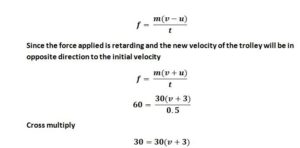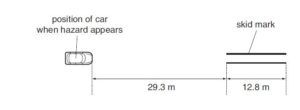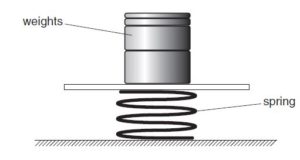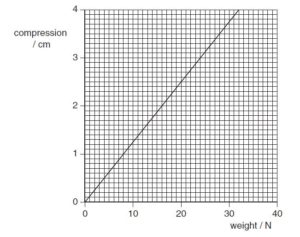Solving questions on deformation of solids, kinematics and dynamics

Q1
A supermarket trolley, total mass 30 kg, is moving at 3.0 m s–1. A retarding force of 60 N is applied
to the trolley for 0.50 s in the opposite direction to the trolley’s initial velocity.
What is the trolley’s new velocity after the application of the force?{cambridge oct/nov 2009 p11}
A 1.0 m s–1 B 1.5 m s–1 C 2.0 m s–1 D 2.8 m s–1
Solution

v +3 = 1
v = -2 ms-1{ -ve shows that speed is in opposite direction}
C is the correct option
Q2
A car is travelling along a straight road at speed v. A hazard suddenly appears in front of
the car. In the time interval between the hazard appearing and the brakes on the car coming
into operation, the car moves forward a distance of 29.3 m. With the brakes applied, the front
wheels of the car leave skid marks on the road that are 12.8 m long, as illustrated in figure below

It is estimated that, during the skid, the magnitude of the deceleration of the car is 0.85 g,
where g is the acceleration of free fall.{Cambridge oct/Nov 2008 p2}
(i) the speed v of the car before the brakes are applied,
(ii) the time interval between the hazard appearing and the brakes being applied.
Solution
Speed of car is V
The skid mark is 12.8 m
So deceleration = 0.85g = 0.85*9.81 ms-2
using

I used negative sign because the car decelerates
If you do your calculation very well
U = 14.61ms-1
To calculate the time

Since the car was travelling at a stead speed

t = 2 s
Q3
A spring is placed on a flat surface and different weights are placed on it, as shown in the figure below

The variation with weight of the compression of the spring is shown below

The elastic limit of the spring has not been exceeded.{Cambridge may/june 2008 p2}
i Determine the spring constant k of the spring.
ii Deduce that the strain energy stored in the spring is 0.49 J for a compression of 3.5 cm
Solution
The spring constant can be calculated by finding the inverse of the slope of the graph
K = 32/ 0.04 = 800Nm-1
Strain energy stored

Q4
The Young modulus of steel is determined using a length of steel wire and is found to have the
value E.
Another experiment is carried out using a wire of the same steel, but of twice the length and half
the diameter.
What value is obtained for the Young modulus in the second experiment?{ Cambridge may/june 2008 p1}
![]()
Solution
From the explanation of Young modulus that I can. It does not change with change in length, it only depend on the material it made up of and not the length.
so, the Young modulus will remain the same
C is the correct option
Note
I will highly appreciate if questions can be asked to know if you have gotten atleast some understanding of the four topics taught so far.
